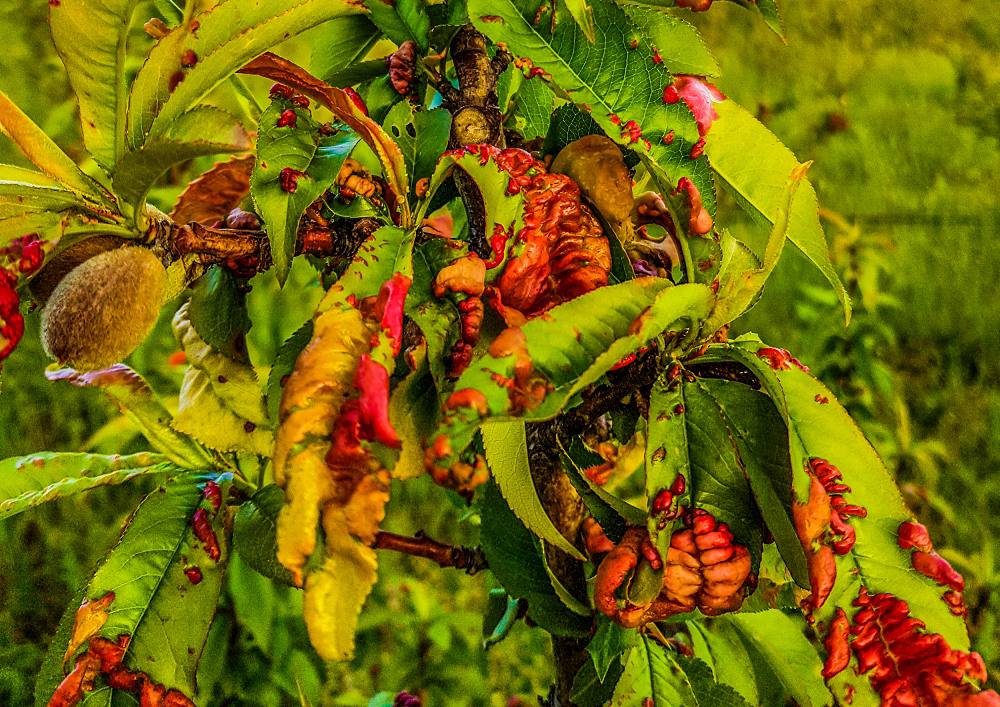Some fruit tree leaf problems are harmless, while others can signal serious trouble for your trees and future harvests. We’re here to help you figure out the difference.
In this comprehensive guide we’ll help you identify what issue you have with your fruit tree leaves and how to treat the problem.

Common Leaf Problems
Different types of fruit trees tend to experience leaf problems for different reasons. We find the easiest way to help home fruit growers to identify their leaf issues is to approach it from a seasonal perspective.
Seasonal Leaf Issues Guide
Spring 🌿
This is when fruit trees burst into life, and their leaves should be vibrant green, and healthy. Deciduous trees (like apples, pears, and peaches) will produce fresh new leaves after being bare all winter, while evergreen trees (like citrus, olives, and avocados) will continue growing new leaves alongside older ones. Spring is the powerhouse of the fruit season! Any curled, discolored, or stunted new leaves at this stage are likely to indicate a problem, so it’s a key time to pay attention. Keep an eye out for emerging fungal diseases, which thrive in the warmer, damper conditions of spring.
- Our Leaf Problem Identification Guide has a handy table to help you identify which fungal disease
- If you’re seeing curling leaves in spring, jump to the section below on leaf curl.
- If you’re seeing yellow leaves review the section below.
Summer ☀️
Leaves should be full, lush, and deep green, actively photosynthesizing to support fruit development. Deciduous trees may show slight yellowing or curling in extreme heat but should remain mostly healthy if well-watered. By the end of summer, many leaves may be starting to look tatty from general wear and tear. Evergreens should maintain thick, waxy leaves, though some older leaves may naturally drop. Watch for signs of heat stress, sunburn, or pest damage, which can appear as scorched edges, wilting, or sticky residue.
Autumn/Fall 🍂
This is the transition period. Deciduous trees will start turning shades of yellow, red, or brown as they prepare to drop their leaves—this is normal and not a concern, and the leaves can be used to add organic matter to your soil. However, early or patchy yellowing might indicate nutrient deficiencies, disease, or lack of water. Evergreens will remain green but may shed some older leaves as part of their natural cycle.
Winter ❄️
Deciduous trees will be completely bare, conserving energy for spring. Any lingering leaves that are shriveled or spotted may be a sign of disease, and winter pruning is the perfect time to remove them. There should be no leaves left on the ground by the time new leaves emerge in spring. Evergreens should still have a full canopy, though growth will slow. Some slight yellowing of older leaves is normal, but widespread discoloration or leaf drop in an evergreen could signal cold damage, root problems, or nutrient deficiencies. It’s common for citrus trees and other evergreens to experience some yellowing of leaves in cooler climates.
Access our Quick Leaf Problem Identification Guide
It covers the common leaf issues you’re likely to see to help you diagnose and fix leaf problems quickly, so your trees stay healthy and productive.
What Is Leaf Curl?
A lot of gardeners are surprised to learn that Leaf Curl disease only affects peaches and nectarines. If you’ve noticed curly leaves on other trees, they are caused by something else.
Some of the most common causes outside of the leaf curl disease are:
- pests (aphids are one of the most common),
- lack of water, or…
- too much water (confusing, right?),
- nutritional problems.
Citrus, apple, and plum trees all have specific issues that can cause leaves to become curled, yellow, or otherwise blemished. Please review our indepth articles for each of these trees.
Leaf curl is caused by Taphrina deformans (ext link: ) and appears in spring as distorted, thickened, and discolored leaves, ranging from red to yellow, which eventually fall off. This disease can weaken trees by reducing their ability to photosynthesize, leading to diminished fruit production and increased vulnerability to other pests and diseases .
Identifying the Cause
While leaf curl is specific to peaches and nectarines, similar symptoms in other fruit trees may have different causes:
- Plums and Cherries: Often affected by aphids, which cause leaves to curl. Look for clusters of small insects inside curled leaves. We have a guide and images to help you identify these buggers available in our Apid control article
- Citrus Trees: Leaf curling can result from water stress (either too much or too little), nutrient deficiencies, or pest infestations. Read more about Citrus fruit leaf curl
- Apples: Leaf curl may be due to pests like aphids or environmental stressors. Read our dedicated Apple Leaf Curl article.
Prevention and Management
Preventing leaf curl involves timely action with the use of an organic fungicide, such as copper-based sprays, during late winter or early spring at the “bud swell” stage before leaves emerge. Timing is crucial; spraying after infection will not get rid of the disease. We have a detailed guide on the organic and effective approach to spraying.
You should also remove and dispose of infected leaves, especially those that have fallen, to reduce the spread of spores.
Soil health is another key approach to creating healthy tree through the soil, eliminating the instances of leaf curl. Read more about how we approach soil health on our own organic fruit farm – honest they are easy and simple approaches.
Read our comprehensive article on all things related to Leaf curl
Yellow leaves on fruit trees
In autumn, it’s normal for deciduous fruit trees to exhibit yellowing leaves as they enter dormancy. However, when your leaves are turning yellow outside of this seasonal change, then what are the possible causes?
Water-Related Stress: Yellow leaves appearing during the growing season might indicate water stress. Both insufficient and excessive watering can lead to similar symptoms. For instance, a blocked irrigation system or poor soil drainage can cause uneven yellowing, where affected trees display yellow leaves while neighboring trees remain green.
Nutrient Deficiencies: Essential nutrient shortages, particularly of iron, manganese, and zinc, can cause leaves to yellow. This is especially common in fruit trees grown in sandy or depleted soils. Citrus trees, for example, often show yellowing along the veins due to iron deficiency, a condition known as chlorosis.
Diseases and Pests: Yellowing leaves can also result from diseases or pest infestations. Symptoms to watch for include mottled patterns, dieback, cankers, sticky residue, visible insects, or distorted growth. These signs may indicate viral diseases or pest-related issues that require attention. We have detailed more on these diseases on our Yellow Leave deep dive page.
Addressing Yellow Leaves
To remedy yellowing leaves:
- Enhance Soil Health: Incorporate compost, aged manure, or worm castings to improve soil fertility. Applying compost tea can introduce beneficial microbes and enhance nutrient availability.
- Manage Watering: Ensure consistent and adequate watering, checking for proper drainage and adjusting irrigation as needed.
- Monitor for Pests and Diseases: Regularly inspect trees for signs of pests or diseases and take appropriate measures to control them.
Access our Quick Leaf Problem Identification Guide
It covers the common leaf issues you’re likely to see to help you diagnose and fix leaf problems quickly, so your trees stay healthy and productive.
Maintaining Fruit Trees to Prevent Leaf Problems
There are many different potential reasons for problems with the leaves on your fruit trees. You might be surprised to learn that the common thread beneath them all is soil health. Healthy soil acts like the immune system for your tree.
If your trees are growing in healthy soil (whether in the ground or a pot), many leaf problems will disappear or not happen in the first place.
When we first converted our farm to organic production in 2008 our fruit trees had every problem under the sun! Our leaves were ravaged by diseases, spots, holes, and lots of pest insects.
We were pleasantly surprised to discover that as our soil gradually improved through the use of compost and a worm farm, many of the problems we had started to disappear. The trees seemed to attract fewer pests, and we even discovered that compost tea can help to fix yellow leaves.
We’ve seen firsthand that looking after the soil will create the right conditions for your trees to have strong, shiny, healthy leaves.
Need more help? Check out more fruit tree leaf resources
Free Resources
Still unsure what’s causing the problem with your fruit tree leaves?
We get it—you’re not alone! Leaf issues can be tricky to diagnose because they can be caused by so many different things. The good news is, we’ve put together plenty of resources to help you delve deeper.
🍃 Download Quick Leaf Problem Identification Guide
🍃 Why does my tree have yellow leaves?
🍃 Understanding and treating leaf curl
Grow Great Fruit Program
Are you worrying about the leaves on your fruit trees? Let’s get to the bottom of that—and set you up for your best fruit-growing year yet.
In the Grow Great Fruit program, we help you tackle leaf problems and we give you skills to grow healthier trees and bigger harvests across your whole orchard.
Each week you get a checklist of seasonal jobs to prevent issues before they start. There are step-by-step videos and guides on pruning, pest and disease prevention, and every other fruit growing topic.
Need answers? The Members Forum is full of answered questions from other growers who’ve been in your shoes. And Premium members get personal answers to questions from us for quick, expert support.
Let’s get your fruit trees thriving—this season and beyond.



